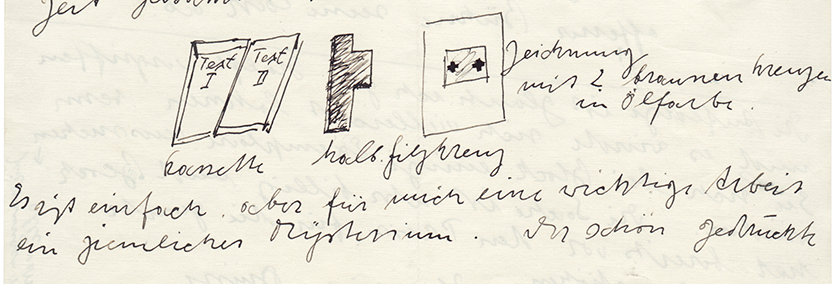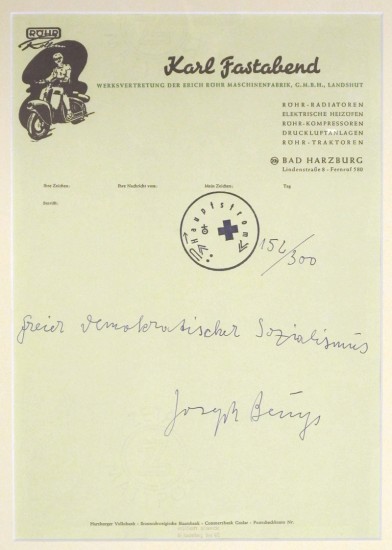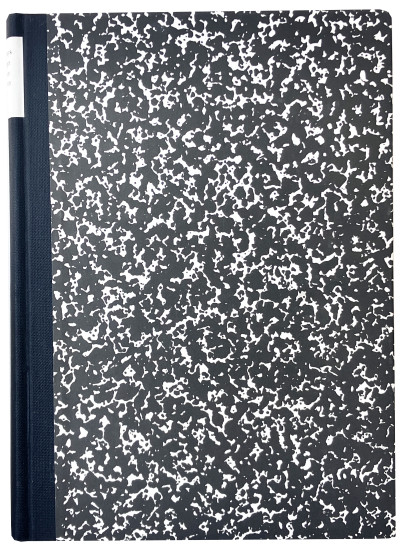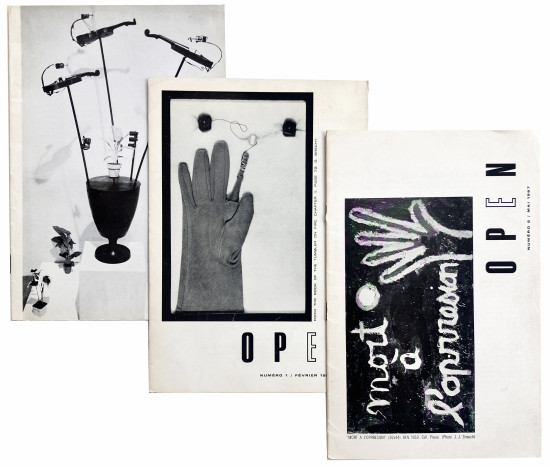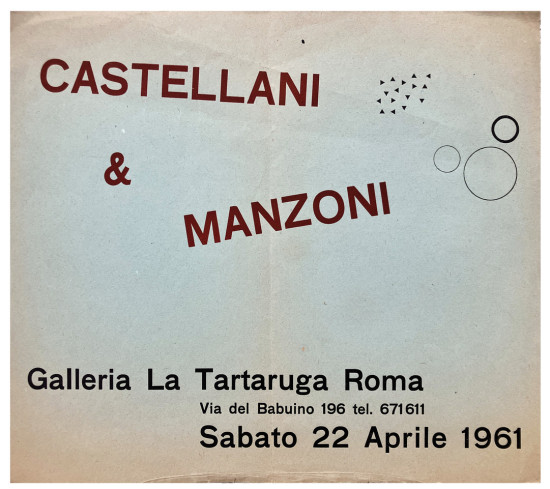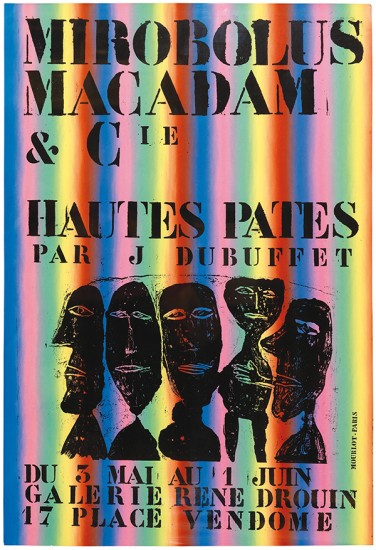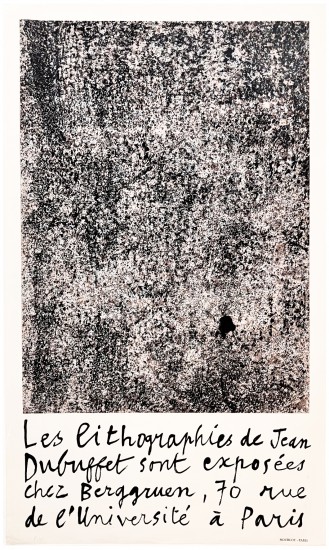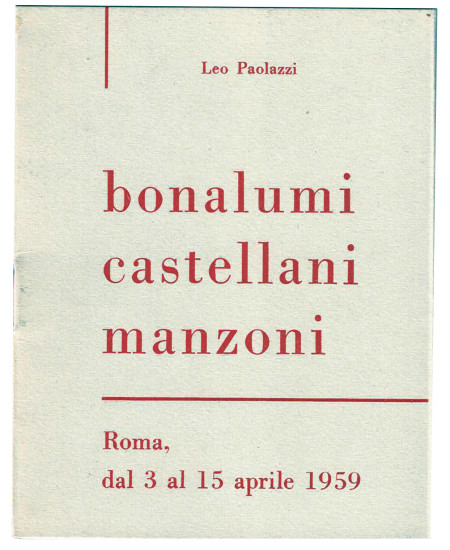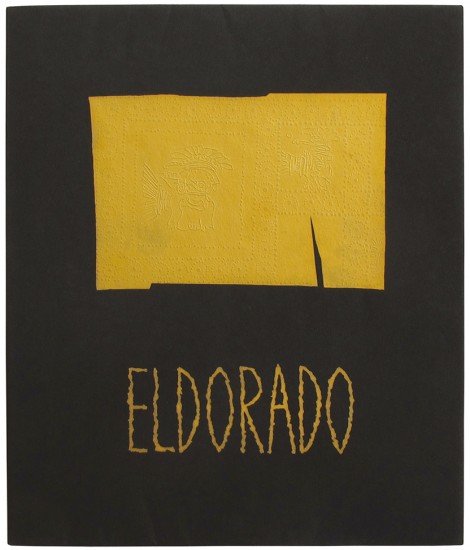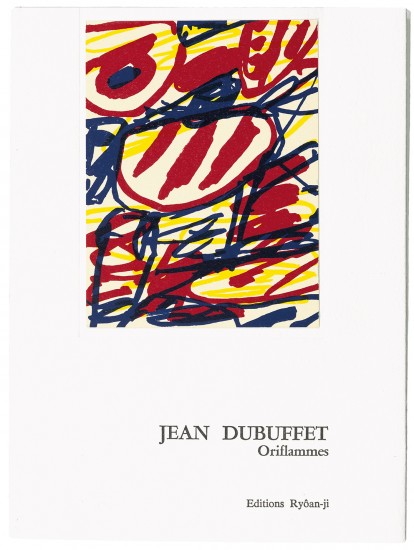... Mit Braunkreuz. ( ... With Browncross). Original Letter by Beuys to 'Monsignore Mauer' Concerning the Seminal Multiple
Beuys, Joseph
Düsseldorf. 1966, 16 Nov
A highly important letter from Joseph Beuys to Monsignor Otto Mauer of Galerie Nächst Saint Stephan concerning the early multiple ' ... mit Braunkreuz'.
The multiple ' … mit Braunkreuz' is of particular significance for Beuys' oeuvre as it incorporates so many of the themes and currents, here still in development, that came to dominate his work. It seems clear from the letter that Beuys seeks to convey that significance to Mauer, a man whose intellect would allow him to grasp it and whose influence would allow its dissemination. Stemmler (see below) notes that an entire book could be written about the interplay of theme, content and interpretation and the interrelated signifcances thereof.
Beuys opens his letter effusively, greeting Mauer as 'Sehr geehrter, lieber Monsignor Mauer!' before thanking him for his thoughts (referring to an earlier letter to Beuys) and beginning his explanation of his multiple ' ... mit Braunkreuz' published by Edition René Block earlier in the same year. In addition to Beuys' explanation, which takes up much of the letter, the artist has sketched an explanatory drawing, towards the foot of the first page showing each element: at left, 'Kassette' with two texts, 'Text I' and 'Text II', at centre the felt piece 'halb. Filzkreuz' and at right the 'Zeichnung mit 2 braunen Kreuze in Ölfarbe'. Beuys continues 'Es ist einfach, aber für mich eine wichtige Arbeit ein ziemliches Mysterium' (It is simple, but for me an important work, a relative mystery).
Overleaf, Beuys explains the content of the multiple, consisting as per his drawing, of two framed typed texts, 'GIOCONDA III' (i.e. 'Text I' of the drawing) and ''BÜHNESTÜCK I', (i.e. 'Text II'), elucidating his allusive prose and following the typography of each of them - both refer to actions and performances by Beuys - as published. The two texts, each important in terms of reference and interleaved with Beuys' artistic philosophy, experiential mysticism and thought processes (referring to Greek mythology, Leonardo, the Swedish chemist, Berzelius, the theatre and cooking) are the source of much speculation and exegesis (see below) and it seems clear that he was concerned to convey the detail in toto to Mauer. The other parts of the multiple, illustrated in the drawing, are the half felt cross and the original drawing with the cross painting, a symbol that became - at least from this multiple onward - very significant for Beuys.
Beuys soon returns to less complicated matters: the sale of drawings to the Albertina and the sale of ' ... mit Braunkreuz' by Block. Beuys suggests that half of the edition of 26 copies has already been sold and that Block is preparing to raise the price for the remaining copies. Beuys signs off with his typical 'Herzliche Grüsse' before adding a postscript suggesting that Mauer may want two or three copies of ' … mit Braunkreuz'.
Monsignor Otto Mauer, was a Catholic priest and collector who founded the Galerie Saint Stephan (later the Galerie nächst Saint Stephan) in Vienna's Grünangergasse next to the Stephansdom. Cited as the 'driving force behind the revitalisation of Austrian art after the Second World War', Mauer was a keen proponent of abstraction and conjoined with his intellectual leanings, founded the gallery as a place for the exchange of ideas and a platform for the avant garde. Mauer remained director of the gallery until his death and was an early champion of performance and installation - Beuys' work included - as well as contemporary art in all its forms and varieties.
A full transcription of the letter is available on request.
'Browncross: This term designates a type of brown primer frequently used by Beuys. ' ... brown ... is a densely covered red - the will to sculptural form. Brown is earth, suppressed red, earthly warmth, dried blood. But it's through this suppression that the colors of light or of the spectrum are thrown up by contrast and emphasized.' (Beuys, in: Coyote, pg. 28; see Schellman, pg. 428).
'The divided cross motif initially occurred in connection with the notion of 'EURASIA'. To Beuys' way of thinking, the political division of the contiguous landmass of of Europe and Asia into East and West was accompanied by a spiritual distinction between Eastern and Western Man. The bisected cross was a symbol of this division, and at the same time a new symbol of unity.' (Uwe M. Schneede in 'Die Aktion', pg. 129; see Schellman, pg. 428).
'In multiples such as ' ... mit Braunkreuz' ( ... with Browncross), 1968, (No. 3) - about which a separate book could be written due to the twenty-six different accompanying drawings that correspond to the edition and the use of nearly every key motif in Beuys' early work - these possibilities ['the plurality of energetic relationships among several elements'] converge without losing their wealth of associations. While the homogeneous felt shape bears a correspondence with the more compact 'Bühnestück I' (Stage Piece I), the open, differentiated, and twenty-six times exchangeable drawing corresponds with the more complex two-second piece 'Gioconda III'. Nevertheless, all 4 parts of the multiple are linked in terms of meaning. The two movable pieces, felt and drawing, e.g., are linked not only externally by the brown crosses ('Braunkreuze') on the periphery of the images ... the brown crosses function as a sign of integration. As such they are a confessional sign, and at the same time a demarcation of fields of tension. The 'BEUYS' stamp with crosses on the bisected felt cross is orientated towards its missing half, upwards, which tends to heighten the character of supplementation. The halved cross ... forms the prototype of the multiple constituent (No. 3). The halved cross also seems to be a visual embodiment of what Beuys himself describes as a complementary or counter-image conception ... In general, Beuys does not see it as a longing for the missing half of something, but as an association of the missing opposite. The two-second piece 'Gioconda III', conceived in 1961, represents a highly complex interplay of several central figures as Beuys experiences them on several levels.' (Dierk Stemmler quoted in Schellman, pp. 509 - 510).
[see Schellman 3 for the multiple; see Schellman pp. 509 - 510; see 'Joseph Beuys: Werbung für die Kunst', 2012, pg. 95 for this letter].
The multiple ' … mit Braunkreuz' is of particular significance for Beuys' oeuvre as it incorporates so many of the themes and currents, here still in development, that came to dominate his work. It seems clear from the letter that Beuys seeks to convey that significance to Mauer, a man whose intellect would allow him to grasp it and whose influence would allow its dissemination. Stemmler (see below) notes that an entire book could be written about the interplay of theme, content and interpretation and the interrelated signifcances thereof.
Beuys opens his letter effusively, greeting Mauer as 'Sehr geehrter, lieber Monsignor Mauer!' before thanking him for his thoughts (referring to an earlier letter to Beuys) and beginning his explanation of his multiple ' ... mit Braunkreuz' published by Edition René Block earlier in the same year. In addition to Beuys' explanation, which takes up much of the letter, the artist has sketched an explanatory drawing, towards the foot of the first page showing each element: at left, 'Kassette' with two texts, 'Text I' and 'Text II', at centre the felt piece 'halb. Filzkreuz' and at right the 'Zeichnung mit 2 braunen Kreuze in Ölfarbe'. Beuys continues 'Es ist einfach, aber für mich eine wichtige Arbeit ein ziemliches Mysterium' (It is simple, but for me an important work, a relative mystery).
Overleaf, Beuys explains the content of the multiple, consisting as per his drawing, of two framed typed texts, 'GIOCONDA III' (i.e. 'Text I' of the drawing) and ''BÜHNESTÜCK I', (i.e. 'Text II'), elucidating his allusive prose and following the typography of each of them - both refer to actions and performances by Beuys - as published. The two texts, each important in terms of reference and interleaved with Beuys' artistic philosophy, experiential mysticism and thought processes (referring to Greek mythology, Leonardo, the Swedish chemist, Berzelius, the theatre and cooking) are the source of much speculation and exegesis (see below) and it seems clear that he was concerned to convey the detail in toto to Mauer. The other parts of the multiple, illustrated in the drawing, are the half felt cross and the original drawing with the cross painting, a symbol that became - at least from this multiple onward - very significant for Beuys.
Beuys soon returns to less complicated matters: the sale of drawings to the Albertina and the sale of ' ... mit Braunkreuz' by Block. Beuys suggests that half of the edition of 26 copies has already been sold and that Block is preparing to raise the price for the remaining copies. Beuys signs off with his typical 'Herzliche Grüsse' before adding a postscript suggesting that Mauer may want two or three copies of ' … mit Braunkreuz'.
Monsignor Otto Mauer, was a Catholic priest and collector who founded the Galerie Saint Stephan (later the Galerie nächst Saint Stephan) in Vienna's Grünangergasse next to the Stephansdom. Cited as the 'driving force behind the revitalisation of Austrian art after the Second World War', Mauer was a keen proponent of abstraction and conjoined with his intellectual leanings, founded the gallery as a place for the exchange of ideas and a platform for the avant garde. Mauer remained director of the gallery until his death and was an early champion of performance and installation - Beuys' work included - as well as contemporary art in all its forms and varieties.
A full transcription of the letter is available on request.
'Browncross: This term designates a type of brown primer frequently used by Beuys. ' ... brown ... is a densely covered red - the will to sculptural form. Brown is earth, suppressed red, earthly warmth, dried blood. But it's through this suppression that the colors of light or of the spectrum are thrown up by contrast and emphasized.' (Beuys, in: Coyote, pg. 28; see Schellman, pg. 428).
'The divided cross motif initially occurred in connection with the notion of 'EURASIA'. To Beuys' way of thinking, the political division of the contiguous landmass of of Europe and Asia into East and West was accompanied by a spiritual distinction between Eastern and Western Man. The bisected cross was a symbol of this division, and at the same time a new symbol of unity.' (Uwe M. Schneede in 'Die Aktion', pg. 129; see Schellman, pg. 428).
'In multiples such as ' ... mit Braunkreuz' ( ... with Browncross), 1968, (No. 3) - about which a separate book could be written due to the twenty-six different accompanying drawings that correspond to the edition and the use of nearly every key motif in Beuys' early work - these possibilities ['the plurality of energetic relationships among several elements'] converge without losing their wealth of associations. While the homogeneous felt shape bears a correspondence with the more compact 'Bühnestück I' (Stage Piece I), the open, differentiated, and twenty-six times exchangeable drawing corresponds with the more complex two-second piece 'Gioconda III'. Nevertheless, all 4 parts of the multiple are linked in terms of meaning. The two movable pieces, felt and drawing, e.g., are linked not only externally by the brown crosses ('Braunkreuze') on the periphery of the images ... the brown crosses function as a sign of integration. As such they are a confessional sign, and at the same time a demarcation of fields of tension. The 'BEUYS' stamp with crosses on the bisected felt cross is orientated towards its missing half, upwards, which tends to heighten the character of supplementation. The halved cross ... forms the prototype of the multiple constituent (No. 3). The halved cross also seems to be a visual embodiment of what Beuys himself describes as a complementary or counter-image conception ... In general, Beuys does not see it as a longing for the missing half of something, but as an association of the missing opposite. The two-second piece 'Gioconda III', conceived in 1961, represents a highly complex interplay of several central figures as Beuys experiences them on several levels.' (Dierk Stemmler quoted in Schellman, pp. 509 - 510).
[see Schellman 3 for the multiple; see Schellman pp. 509 - 510; see 'Joseph Beuys: Werbung für die Kunst', 2012, pg. 95 for this letter].
4to. (297 x 210 mm). Single leaf of cream A4 paper with triple circular watermark 'MK / PAPER' with Beuys' manuscript in black ink recto and verso, dated 'Düsseldorf, den 16 November 1966' and addressed to Sehr geehrter, lieber Monsignore Mauer!', recto with small drawing of the multiple with explanatory annotations, additional marginalia to verso, signed 'Herzliche Grüsse / von Joseph Beuys' at foot of verso; text in German throughout. Two punched holes (for filing) at right of sheet edge restored.
#47144


